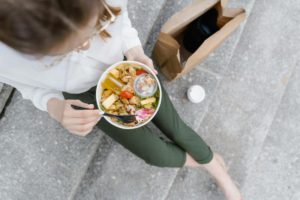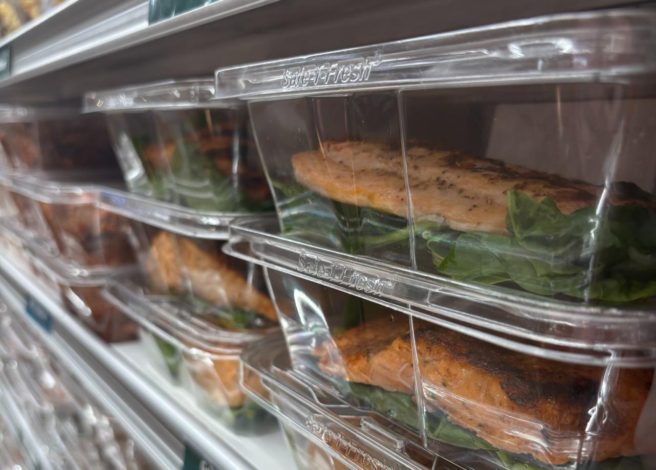At a Glance
- PET Packaging Boosts Visibility: Crystal-clear PET packaging enhances product appeal, improves sales, and simplifies inventory management, lowering handling costs.
- Extends Shelf Life: PET’s strong oxygen barrier keeps products fresh longer than packaging with lower barrier properties such as paper or polystyrene, reducing waste compared to other materials.
- Sustainable & Adaptable: PET has a robust recycling infrastructure, making it an eco-friendly, future-proof choice for packaging.
- Cost & Operational Efficiency: PET reduces shipping costs, waste, and production inconsistencies, delivering long-term savings.
Walk through any grocery store’s fresh food section and you’ll notice something: the best-performing products share a common trait. No, that trait isn’t that the products are organic, locally sourced, or encourage any specific diet. The foods that sell the best are often packaged in crystal-clear containers that showcase their contents while maintaining freshness far longer than other common packaging materials, such as paper or polystyrene.
Material selection in food packaging isn’t just about cost per pound — it’s about total system performance. We’ve worked with PET (polyethylene terephthalate), a clear and durable material, for more than 20 years to develop innovative packaging solutions. And in a recent conversation with a major PET sheet supplier, we confirmed why this material has emerged as the leading choice for cold and ambient fresh food applications.
This article will explore how PET became the best friend for fresh food. It will reveal the hidden costs of inferior packaging materials, show you exactly how PET packaging solves these problems, and provide a clear roadmap for making the switch that protects both your products and your profits.
The Fresh Food Packaging Crisis
Food packaging experts often face a familiar nightmare. They worry that premium products can look unappealing, taste off, or spoil before reaching consumers. The financial impact is brutal. Product recalls can cost millions. Customer complaints can damage a brand’s reputation for years. When eco-conscious consumers complain about sustainability, it causes PR problems.
Let’s take a deep breath. That was a lot to bring up at once.
Here’s something many overlook: the real problem often isn’t the product itself. This decision about packaging materials was made months ago. It relied on limited information and focused on short-term costs.
 Traditional packaging materials create a cascade of problems. Polystyrene foam containers look inexpensive. They don’t protect well, causing shorter shelf life and more waste. Not to mention the current foam bans that are sweeping the country. Paper-based alternatives look green, but they have moisture issues and weak barriers (among a host of other problems). And let’s not forget ‘compostable’ packaging, which actually isn’t compostable at all, unless under the right conditions.
Traditional packaging materials create a cascade of problems. Polystyrene foam containers look inexpensive. They don’t protect well, causing shorter shelf life and more waste. Not to mention the current foam bans that are sweeping the country. Paper-based alternatives look green, but they have moisture issues and weak barriers (among a host of other problems). And let’s not forget ‘compostable’ packaging, which actually isn’t compostable at all, unless under the right conditions.
The worst part? These problems compound throughout the supply chain. Distribution centers struggle with inventory management when they can’t quickly assess product quality. Retailers face increased labor costs from handling complaints and processing returns. Consumers lose trust in brands when products consistently disappoint.
PET Steps in to Save the Day
The solution isn’t to accept these trade-offs — it’s to choose materials that eliminate them entirely. After working with top food brands and plastic sheet producers, we found what makes fresh food packaging effective. We also pinpointed the traits that can lead to problems in less successful options.
The winning material should be clear and have strong barrier properties. It must also be recyclable and produced reliably. It needs to perform across the entire supply chain, from production line to consumer table. Most importantly, it must provide total system value, not just low unit cost.
That material is PET, and here’s exactly how it steps up to any major packaging challenge for cold and ambient fresh food.
The PET Solution: A Three-Step System
This isn’t theoretical — it’s a proven approach that’s working for major food brands right now. Here’s the exact system that transforms fresh food packaging from a source of problems into a competitive advantage.
Step 1: Eliminate Visibility Problems with Crystal Clarity

When consumers shop for fresh food, they buy with their eyes first, which explains why nobody ever bought a salad in a paper bag. PET provides clear visibility that few other materials can match. This transparency influences sales and lowers food waste. It lets consumers make better choices when buying.
The clarity advantage extends throughout the supply chain. Foodservice operators and retailers can easily check product quality. They don’t need to open packages. This helps with inventory management and cuts handling costs, and in an industry where every second counts, PET’s optical clarity gives it a strong edge. No one has time to gamble with their produce packaging.
Step 2: Extend Shelf Life with Superior Barrier Protection
PET’s molecular structure offers excellent oxygen barrier performance, even without extra barrier layers. Compared to other common food packaging materials, this protection extends shelf life and reduces product loss — often making the difference between profit and waste.
Packages that use special gas mixtures to keep food fresh are known as “Modified-Atmosphere Packaging” (or “MAP”). In many materials, extra coatings are needed to improve gas and moisture barriers for MAP performance — but PET’s natural barrier strength often eliminates that need. This makes packaging simpler while keeping products just as safe. Food safety teams love PET’s consistent performance — protecting products the same way every time while ensuring compliance and reducing variability and risk.
Step 3: Prepare for the Future with Sustainable Packaging Options
Demand for eco-friendly packaging is growing, and regulations are tightening. PET has one of the most developed recycling infrastructures among food packaging plastics, making it a strong option to consider when planning long-term packaging strategies.
The established recycling infrastructure creates a robust market for post-consumer content. This provides supply chain stability that other materials cannot match. When regulations change or consumer preferences shift, PET-based packaging systems evolve. They adapt instead of becoming outdated.
What Happens When You Make the Switch? (Spoiler: Success Happens)
 Companies that transition to PET packaging from other packaging materials, such as paper, report immediate improvements across multiple metrics. Product returns decrease as consumers can better assess quality before purchase. Shelf-life extensions reduce waste throughout the distribution chain.
Companies that transition to PET packaging from other packaging materials, such as paper, report immediate improvements across multiple metrics. Product returns decrease as consumers can better assess quality before purchase. Shelf-life extensions reduce waste throughout the distribution chain.
The operational benefits compound over time. Production consistency improves because PET is manufactured to well-established industry specifications, giving it highly uniform barrier, clarity, and strength characteristics from batch to batch. In contrast, some bio-based or mixed resins can vary more in quality and performance due to differences in feedstock sources or processing methods, increasing the risk of quality issues. PET’s reliability supports smooth, efficient production, while bioplastics like PLA or PHA present additional challenges, such as potential contamination of recycling streams.
PET’s lightweight nature supports sustainability by lowering transportation emissions, reducing the energy required to move goods, and cutting shipping costs compared to heavier materials like glass. It also offers strong product protection, and these benefits compound quickly when applied to millions of packages.
Overcoming the Perception Challenge
Despite PET’s advantages, one obstacle remains: the “all plastic is just plastic” misconception. Many consumers lump all plastics together, overlooking important differences in performance, recyclability, and environmental impact. This is especially damaging when paired with the mindset that “all plastic is bad.”
The good news? This creates an opportunity for brands to educate customers about material differences.
Compared to other common food packaging plastics — such as polystyrene (PS), polypropylene (PP), polyethylene (PE), and bio-based plastics like PLA — PET has a stronger recycling infrastructure, higher recovery rates, and fewer environmental drawbacks. For example, PS is difficult to recycle, PP often lacks widespread recycling collection, and PE’s recycling systems are less established for food-grade reuse.
Money Talks: The Economics of Excellence
 Smart packaging decisions consider total system costs, not just material price per pound. PET’s superior performance characteristics often deliver lower total costs. Extended shelf life reduces waste. Improved clarity reduces returns. Recycling infrastructure provides end-of-life value.
Smart packaging decisions consider total system costs, not just material price per pound. PET’s superior performance characteristics often deliver lower total costs. Extended shelf life reduces waste. Improved clarity reduces returns. Recycling infrastructure provides end-of-life value.
Transportation efficiency becomes particularly important for regional and national distribution systems. Lower shipping weights mean less fuel use, lower logistics costs, and smaller carbon footprints. These benefits add up across all product lines.
Per-PET-ual Success
PET provides clear solutions to the problems that worry food packaging experts. PET turns packaging challenges into advantages. It offers clarity that boosts sales and barrier properties that extend shelf life. Plus, it proves recyclability and ensures consistent manufacturing.
The issue isn’t whether PET can fix your fresh food packaging problems. It’s whether you can afford to keep using materials that cause those issues. The companies winning in fresh food packaging made this transition years ago. The question is: Will you join them, or are you still putting salads in paper bags?
Are you interested in learning more about PET and packaging material options? Visit our Learning Center today and browse a vast array of topics.

